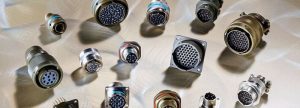 AN connectors are commonly used in the electrical systems of airplanes. AN, of course, is a specification derived from the U.S. military. For over a half-century, the U.S. military has used AN-style connectors in airplanes as well as other vehicles. As part of a joint project, the Army and Navy pioneered the AN specification, which has since made its way into the commercial aviation industry. While all AN connectors follow this specification, they are available in several different classes.
AN connectors are commonly used in the electrical systems of airplanes. AN, of course, is a specification derived from the U.S. military. For over a half-century, the U.S. military has used AN-style connectors in airplanes as well as other vehicles. As part of a joint project, the Army and Navy pioneered the AN specification, which has since made its way into the commercial aviation industry. While all AN connectors follow this specification, they are available in several different classes.
#1) Class A
Class A is the most common type of AN connectors. They consist of a single piece of material for the rear shell. Class A AN connectors are considered general-purpose connectors. In other words, they support a variety of electrical applications.
#2) Class B
Class B AN connectors are those with a multi-piece rear shell. Unlike Class A AN connectors, the rear shell isn’t comprised of a single piece of material. Rather, it features two sections that allow the rear shell to separate. Class B AN connectors allow for access to the soldered electrical contacts. By opening up the rear shell, you can access the electrical contacts.
#3) Class C
There are also Class C AN connectors. Class C AN connectors are defined by their use of pressure. They are pressurized connectors that, like Class A AN connectors, consist of a single rear shell. Class AN connectors are used in applications that require pressurized connectors.
#4) Class D
Another common type of AN connector is Class D. Class D AN connectors offer excellent resistance to moisture. They are designed with a grommet in the rear shell that protects against the intrusion of moisture. The grommet essentially seals the rear shells that water, humidity or other forms of moisture can’t reach the electrical contacts. Class D AN connectors are also resistant to mechanical stress, such as vibrations. Airplanes produce vibrations naturally, which is why they often use Class D AN connectors.
#5) Class K
Finally, Class K AN connectors are designed to operate in extreme heat. They are essentially fireproof connectors. Class K AN connectors are usually longer than other types of AN connectors. Aside from their length, though, the main difference is that Class K AN connectors are fireproof. Even when exposed to a flame, electricity will continue to flow through them. Class K AN connectors are typically used in applications where it’s essential that electricity remains uninterrupted.



